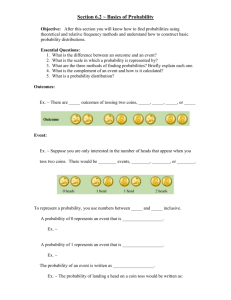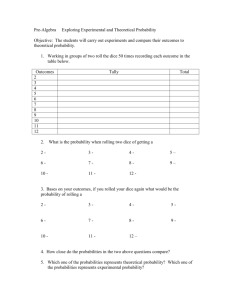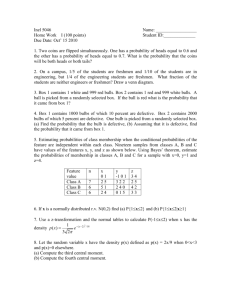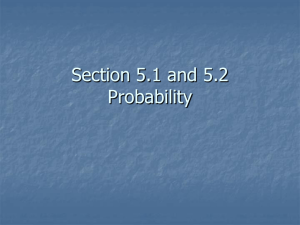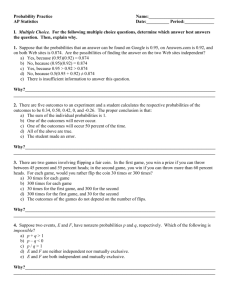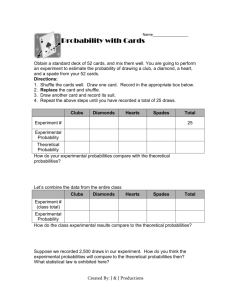Section 6.2 ~ Basics of Probability
advertisement
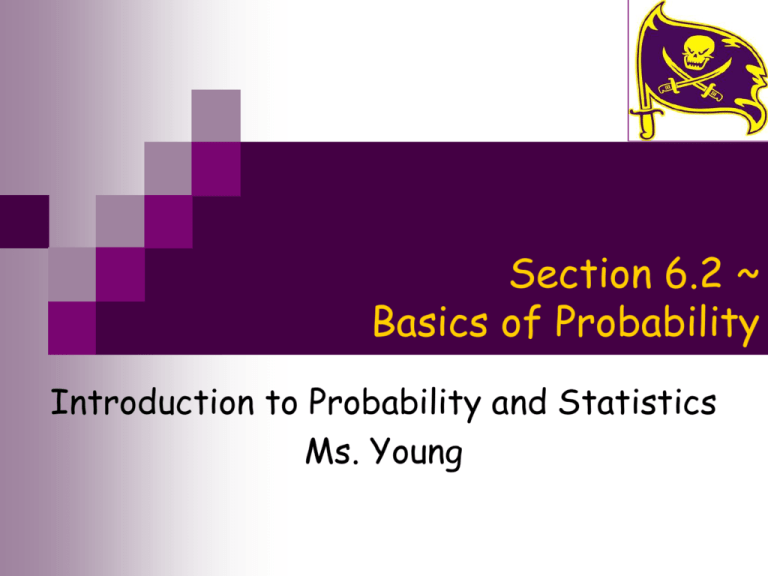
Section 6.2 ~ Basics of Probability Introduction to Probability and Statistics Ms. Young Sec. 6.2 Objective After this section you will know how to find probabilities using theoretical and relative frequency methods and understand how to construct basic probability distributions. Sec. 6.2 Basics of Probability Outcomes – the most basic possible results of observations or experiments Ex. ~ There are four outcomes of tossing two coins, HH, HT, TH, or TT Event – a collection of one or more outcomes that share a property of interest Ex. ~ Suppose you are only interested in the number of heads that appear when you toss two coins. There would be three events, 0 heads (TT), 1 head (HT or TH), or two heads (HH) Sec. 6.2 Basics of Probability Cont’d… To express a probability, you use numbers between 0 and 1 inclusive A probability of 0 would represent an event that is impossible A probability of 1 would represent an event that is certain to occur Ex. ~ Death and taxes! The probability of an event is written as P(event) Ex. ~ Meeting a married bachelor Ex. ~ The probability of landing a head on a coin toss would be written as P(H) = .5 The scale to the right shows common expressions used to represent probabilities based on their level in comparison to 0 and 1 Ex. ~ A probability of .95 indicates that an event is very likely to occur (95 out of 100 times) Ex. ~ A probability of .30 indicates that an event is unlikely to occur (30 out of 100 times) Ex. ~ A probability of .01 describes an event that is very unlikely to occur (1 out of 100 times) Sec. 6.2 Theoretical Probabilities Theoretical probabilities are probabilities that deal with equally likely outcomes (i.e., tossing a fair coin, rolling a fair die, spinning a roulette wheel, etc.) Calculating theoretical probabilities: Step 1: Count the total number of possible outcomes Step 2: Among all the possible outcomes, count the number of ways the event of interest, A, can occur Step 3: Determine the probability, P(A), from P( A) number of ways A can occur total number of outcomes Sec. 6.2 Example 1 Suppose you select a person at random from a large group. What is the probability that the person has a birthday in July? Assume that there are 365 days in a year. Since all birthdays are equally likely, we can use the 3 step process for calculating theoretical probabilities: Step 1: Each possible birthday represents an outcome, so there are 365 possible outcomes Step 2: July has 31 days, so 31 of the 365 possible outcomes represent the event of a July birthday Step 3: The probability that a randomly selected person has a birthday in July is P( A) number of ways A can occur total number of outcomes P(July birthday) 31 0.0849 365 Sec. 6.2 Theoretical Probabilities Cont’d… Counting Outcomes – the total number of outcomes can be found by raising the individual outcome to the number of processes Ex. ~ What is the total number of outcomes of tossing two coins? Each coin has 2 outcomes (H or T), and there are 2 coins (2 tosses or processes), so there are 4 possible outcomes (22 = 4) when tossing two coins Ex. ~ What is the total number of outcomes of tossing three coins? Each coin has 2 outcomes (H or T), and there are 3 coins (3 tosses or processes), so there are 8 possible outcomes (23 = 8) when tossing three coins Sec. 6.2 Example 2 How many outcomes are there if you roll a fair die and toss a fair coin? The first process, rolling a fair die, has six possible outcomes, 1, 2, 3, 4, 5, or 6, and the second process, tossing a fair coin, has two possible outcomes (H or T). The total number of outcomes would be 12 ( 61 × 21). What is the probability of rolling two 1’s (snake eyes) when two fair dice are rolled? Rolling a single die has 6 equally likely outcomes, so rolling two dice has a total of 36 outcomes (62 = 36). Of the 36 outcomes, the event of interest (two 1’s) can only occur one way, so the probability of rolling two 1’s is P(two 1's) 1 0.0278 36 Sec. 6.2 Example 3 What is the probability that in a randomly selected family with three children, the oldest child is a boy, the second child is a girl, and the youngest child is a girl? Assume that having boys and girls is equally likely. There are two possible outcomes for each birth: boy or girl For a family with three children, there would be 8 possible outcomes (23 = 8) BBB, BBG, BGG, GBB, GBG, GGB, GGG The probability of the birth order being BGG is P(BGG) 1 0.125 8 Sec. 6.2 Relative Frequency Probabilities Another method to determine probabilities is to approximate the probability of an event, A, occurring. This is known as the relative frequency (or empirical) method. Ex. ~ If we observe that it rains an average of 100 days per year, we can estimate the probability of it raining on a randomly selected day to be approximately .274 (100/365) Here is the general rule for this method: Step 1: Repeat or observe a process many times and count the number of times the event of interest, A, occurs. Step 2: Estimate P(A) by number of times A occurred P( A) total number of observations Sec. 6.2 Example 4 Geological records indicate that a river has crested above a particular high flood level four times in the past 2,000 years. What is the relative frequency probability that the river will crest above the high flood level next year? P(river will flood next year) 4 1 0.002 2000 500 Because a flood of this magnitude occurs on average once every 500 years, it is called a “500-year flood.” The probability of having a flood of this magnitude in any given year is 1/500, or 0.002. Sec. 6.2 Subjective Probabilities & Summary of Different Methods of Finding Probabilities A third method for determining probabilities is to estimate a subjective probability using experience or intuition Ex. ~ You could make a subjective estimate of the probability that a friend will be married in the next year or the probability that getting a good grade in statistics will help you get the job that you want Three approaches to Finding Probability Theoretical probability – when all outcomes are equally likely, divide the number of ways an event can occur by the total number of outcomes P( A) number of ways A can occur total number of outcomes Relative frequency probability – based on observations or experiments. Divide the number of times the event occurred by the total number of observations number of times A occurred P( A) total number of observations Subjective probability – estimating based on experience or intuition Sec. 6.2 Example 5 Identify the method that resulted in the following statements. a. The chance that you will get married in the next year is zero. Subjective because it’s based on a feeling b. Based on government data, the chance of dying in an automobile accident is 1 in 7,000 (per year). Relative frequency probability because it’s based on observations on passed automobile accidents c. The chance of rolling a 7 with a twelve-sided die is 1/12. Theoretical probability because it is based on assuming that a fair twelve sided die is equally likely to land on any of its twelve sides. Sec. 6.2 Probability of an Event Not Occurring Sometimes you might be interested in finding the probability that a particular event or outcome does not occur Ex. ~ The probability of a wrong answer on a multiple choice question with five possible answers The probability of answering it correctly would be .2 (1/5), so the probability of not answering it correctly would be .8 (4/5) The complement of an event, A, expressed as A, consists of all outcomes in which A does not occur. The sum of the probabilities of A and A must be 1, so the probability of A can be given by P( A) 1 P( A) Sec. 6.2 Example 6 In a grocery store the scanning system was successful 384 out of 419 times. What is the probability that the scanner will not work? 384 P ( A) 1 0.084 419 Sec. 6.2 Probability Distributions A probability distribution is a visual display of the probabilities of certain events occurring in the form of a table or a histogram Ex. ~ Suppose you toss two coins simultaneously. Because each coin can land one of two ways (H or T), there are 4 possible outcomes (HH, TT, HT, & TH). The following table represents the outcomes and probabilities: Out of the 4 outcomes, there are 3 events, 2 heads (HH), 1 head (HT or TH), and 0 heads (TT). These probabilities result in a probability distribution which can represented as a table or a histogram: Sec. 6.2 Probability Distributions Steps to making a probability distribution: Step 1: List all possible outcomes Step 2: Identify outcomes that represent the same event. Find the probability of each event. Step 3: Make a table or a histogram in which one column (or x-axis) represents the events and the other column (or y-axis) represents the probability Example 7: Make a probability distribution table for the number of heads that occur when three coins are tossed simultaneously. Step 1: List all possible outcomes Since there are 3 coins, there are a total of 8 outcomes (23 = 8): HHH, HHT, HTH, HTT, THH, THT, TTH, and TTT (refer to p.241 to see how these outcomes were constructed) Step 2: Identify outcomes that represent the same event. Find the probability of each. Since we are interested in the number of heads that occur, there would be 4 events, 0 heads (1/8 = .125), 1 head (3/8 = .375), 2 heads (3/8 = .375), or 3 heads (1/8 = .125) Sec. 6.2 Probability Distributions Example 7 Cont’d: Make a probability distribution table for the number of heads that occur when three coins are tossed simultaneously. Step 3: Make a table
